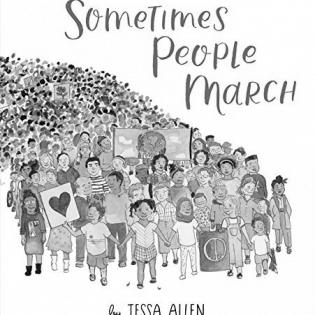Sometimes People March Literature Guide
This is an important book that can inform and inspire the reader to use their voice together with others. It is a celebration of our common humanity and illustrates the importance of working together for positive change.
Literature Guide by Maureen Klein
Before Reading
Ask: What do you know about Dr. Martin Luther King, Jr.’s famous March on Washington?
Show: Look at the illustration on the front of the book. Describe what you notice. What might the symbols drawn on the posters represent?
Connect: People throughout the history of the United States, and even today, march for many different reasons. As you read the book, look closely for examples of why people have marched in the United States.
During Reading
Ask: Pause on the page that reads, “Marching is something people do together when they want to resist injustice.” What does it mean to resist? What is injustice?
Show: Pause again on the page that reads, “Sometimes people carry signs to share their stories of resistance.” Look closely at the signs the people are holding. What do you notice about the people and their signs?
Connect: Many people have worked to make our country more inclusive. The signs on this page represent social justice issues from our past and from our present. Can you identify examples from the past and from the present and explain what they are trying to improve?
After Reading
Ask: What words describe how the people who march felt? How do you know they felt that way, or what examples from the book support your answer?
Show: Re-read the page “Sometimes great change starts small, with a brave question.” How can a question be brave?
Connect: When we listen to each other, our understanding of each other and the world grows. Tell about a time when you had a problem and someone really listened to you. When people march, they are raising their voices together to amplify one message. How can a community demonstrate that it has listened to the people who march?
Activities
- At the back of the book is a list of "Movements, Marches, and Key Figures in the Art" illustrated throughout the book. Read more about one or more of these topics or events. Talk with someone else about what you've learned.
- Create your own poster advocating for positive change in your community.
- Watch this animated short video of the book from HarperCollins. Notice the sounds associated with people marching.
- Social activism has often included art and music. Watch this video from PBS with songs and pictures for the Civil Rights Movement. In what ways can music be an act of resistance or inspiration?
- Look at the pictures in the book for ideas of actions you can take... and do it. Maybe you can clean up a park or write a song or make art.
